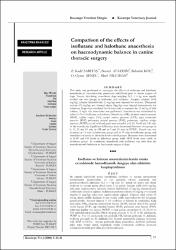Comparison of the Effects of Isoflurane and Halothane Anaesthesia on Haemodynamic Balance in Canine Thoracic Surgery
Abstract
This study was performed to investigate the effects of isoflurane and halothane
anaesthesia on haemodynamic parameters and blood gases in thorax surgery of
dogs. Twenty, free-living, cross-breed dogs weighing 24.2 ± 4 kg, were equally
divided into two groups as isoflurane and halothane. Atropine sulphate (0.04
mg/kg), xylazine hydrochloride (2 mg/kg) were injected for sedation. Thiopental
sodium (15 mg/kg) and fentanyl citrate (5µg/kg) were injected intravenously for
induction. Dogs were ventilated for 16 times/min to maintain the 15 ml/kg of tidal
volume. A right side thoractomy was performed. Anaesthesia was maintained by
either 1.5 % of isoflurane or halothane. Hearth rate (HR), minimal arterial pressure
(MAP), cardiac output (CO), central venous pressure (CVP), right ventricular
pressure (RVP) pulmonary arterial pressure (PAP), pulmonary capillary wedge
pressure (PCWP) as well as blood gases were recorded at 0, 15, 30, 60 and 120 min.
of the anaesthesia. Significant differences were determined between two groups at
0, 15, 30 and 60 min. in HR and at 0 and 15 min. in PCWP. Hearth rate was
increased at 15 min. in halothane group, and at 30 min in isoflurane group, and
thereafter it returned to the initial levels in both groups. Decreases were determined
in MAP and CO levels in halothane group while MAP levels were stable in
isoflurane group. In conclusion, anaesthesia with isoflurane was safer than the
anaesthesia with halothane in the thoracic surgery of dogs. Bu çalışma köpeklerde toraks cerrahisinde izofloran ve halotan anestezisinin
hemodinamik parametrelere ve kan gazlarına etkisini araştırmak için
gerçekleştirilmiştir.Ağırlıkları 24,2 ± 4 kg olan 20 karışık ırk köpek eşit olarak
izofloran ve halotan grubu olmak üzere 2 ‘ye ayrıldı. Atropin sülfat (0,04 mg/kg,
subkutan) enjeksiyonunu izleyerek ksilazin hidroklorid (2 mg/kg, intramuskuler)
verilmesiyle sedasyon sağlandı. İndüksiyon pentotal sodyum (15 mg/kg ) ve fentanil
sitrat‘ın (5 mcg/kg) intravenöz enjeksiyonuyla sağlandı. Köpekler tidal volüm 15
ml/kg olacak şekilde dakikada 16 kez ventile edildi. Sağ torakotomi her iki grupta
gerçekleştirildi. Anestezi idamesi % 1,5 izofloran ve halotan ile sürdürüldü. Kalp
atım sayısı (HR), ortalama arteriyel kan basıncı (MAP), kardiak debi (CO), santral
venöz basınç (CVP), sağ ventrikül basıncı (RVP), pulmoner arter basıncı (PAP),
pulmoner kapillar veç basıncı (PCWP) ve kan gazları, anestezinin 0, 15, 30, 60 ve
120. dakikalarında kaydedildi. HR’de iki grup arasında 0, 15, 30 ve 60. dakikalarda,
PCWP ise 0 ve 15. dakikalarda fark gözlendi. HR, halotan grubunda 15. dakikada,
izofloran grubunda ise 30. dakikada arttı. Sonraki zamanlarda başlangıç seviyesine
indi. MAP ve CO’da Halotan grubunda düşüş gözlenirken, İzofloran grubunda
stabil kaldı. Sonuç olarak, köpeklerde toraks cerrahisinde izofloran anestezisi
halotan anestezisine göre daha güvenli bulunmuştur.
Source
Kocatepe Veteriner DergisiVolume
1Issue
1Collections
- Cilt 1 : Sayı 1 [15]



















